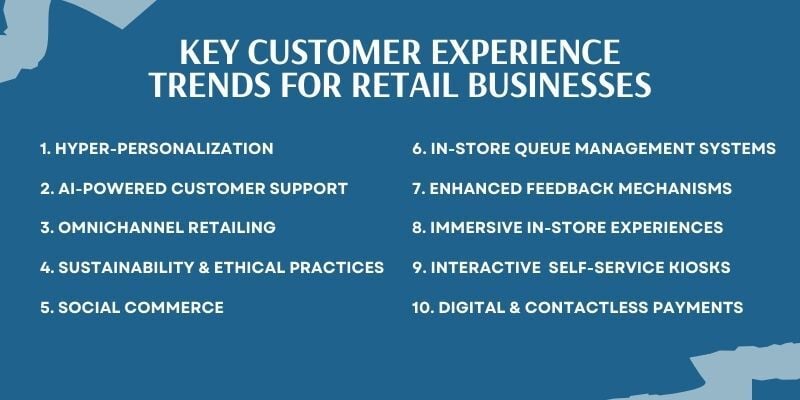Retail success depends on how well businesses address customer needs. When shopping is seamless, personalized, and enjoyable, customers are more likely to return and share positive experiences with others.
In 2025, customer expectations are higher than ever, with shoppers demanding faster service, more convenience, and deeper engagement.
To meet these growing expectations, retailers are embracing technology, data, and customer-focused strategies. AI-driven personalization, quicker checkout systems, and sustainable shopping practices are essential in shaping retail’s future.
These innovations make it easier to predict customer preferences, streamline operations, and enhance engagement. Furthermore, shoppers now prioritize transparency, sustainability, and seamless omnichannel experiences.
Embracing these emerging customer experience trends in retail will help businesses improve satisfaction, build loyalty, and thrive in 2025.
Importance of Adapting Retail Customer Experience Trends
As consumer expectations quickly change, retailers must keep up with the latest customer experience trends. Staying informed and adapting to these trends is vital for maintaining relevance, driving customer loyalty, and achieving long-term success.
Retailers who adopt new trends like AI-driven personalization and seamless, fast service will stand out in a competitive market. Failing to adopt these innovations may cause businesses to fall behind, as competitors can improve customer satisfaction and attract more customers.
The growth of retail customer experience innovations shows this shift: the AI retail market is expected to rise from US$19.51 billion in 2024 to US$53.27 billion by 2029, growing at 36.60% annually.
This fast pace of technological change is reshaping the retail industry. Additionally, 80% of consumers are more likely to purchase from brands that offer personalized experiences.
Retailers who adopt the latest trends will be better positioned to meet rising customer expectations, improve engagement, and increase sales.
Key Customer Experience Trends for Retail Businesses

The customer experience (CX) in retail is rapidly changing, with new trends influencing how businesses interact with shoppers. Retailers must keep up with these changes to meet growing customer expectations, boost satisfaction, and stay competitive.
Here are the top customer experience trends in retail that businesses should focus on in 2025 and beyond:
1. Hyper-Personalization Boosts Conversions by 60%

Hyper-personalization takes basic personalization a step further. It uses advanced AI and behavioral data to create highly customized experiences for each customer. Unlike traditional personalization, which focuses on general demographics, hyper-personalization targets specific behaviors, preferences, and past interactions.
Moreover, hyper-personalization can increase conversion rates by up to 60% compared to traditional campaigns. Thus, it is essential for strengthening customer loyalty and increasing retail sales.
Amazon’s recommendation system is a real-life example of hyper-personalization. It suggests products based on browsing patterns, purchase history, and real-time interactions. This approach drives 35% of Amazon’s total sales, demonstrating its effectiveness in boosting conversion rates and customer retention.
2. 52% of Contact Centers Adopt AI Chatbots

AI-powered customer support has become an important part of modern retail. Technologies like chatbots and generative AI can now handle customer queries and offer immediate, 24/7 assistance. According to 8×8’s research, 52% of organizations have invested in conversational AI capabilities, and 44% plan to adopt them.
Retailers implementing AI-driven customer support have seen significant improvements in customer satisfaction. For example, H&M’s AI-powered chatbot assists online shoppers by recommending outfits based on their style preferences, creating a more interactive and personalized shopping experience.
AI is also moving towards improving sentiment analysis, allowing businesses to detect frustration in customer messages and escalate concerns before dissatisfaction escalates.
So, while AI is great for handling routine questions, retailers must provide human support for more complex or sensitive issues to ensure customers feel understood and valued.
However, as AI technology evolves, future advancements will focus on emotional intelligence, enabling virtual assistants to recognize and respond more effectively to human emotions. Retailers that integrate AI while maintaining a human touch will achieve the best balance between efficiency and customer connection.
3. Omnichannel Retailing
Omnichannel retailing focuses on providing a smooth, integrated shopping experience across online and offline channels. Shoppers now expect consistent service in-store, browsing online, or using mobile apps.
A study found that 7 out of 10 shoppers use multiple channels in their shopping journey, making it crucial for retailers to offer seamless connections between in-store and online experiences.
Therefore, retail businesses should invest in systems integrating customer service, inventory management, and cross-channel support to provide a consistent omnichannel experience.
For example, Nike’s omnichannel approach allows customers to check product availability online before visiting stores. Their mobile app also provides personalized recommendations based on past purchases. This creates a seamless brand experience and reduces friction in the customer journey.
4. Sustainability and Ethical Practices
Consumers are increasingly attracted to brands that prioritize sustainability. In fact, 66% of global shoppers are willing to pay a premium for eco-friendly products. Retailers can make a difference by adopting sustainable practices, such as reducing waste, using renewable materials, and improving supply chain operations to lower their carbon footprint.
A brand that strongly commits to sustainability will enhance its reputation, build trust, and boost customer loyalty. For example, Patagonia’s focus on environmental responsibility has helped it build a dedicated customer base and strengthened its image as a responsible and ethical brand.
Similarly, brands like IKEA are investing in circular economy initiatives, encouraging customers to return used furniture for resale or recycling.
As evolving retail customer experience strategies increasingly focus on sustainability, brands that lead with green practices gain long-term customer loyalty.
Retailers who embed sustainability into their business models will attract environmentally conscious consumers and future-proof their operations against tightening regulations and shifting market expectations.
5. Social Commerce

Social commerce is changing how people shop as more retailers integrate e-commerce directly into social media platforms like Instagram, Facebook, and TikTok. These platforms allow consumers to shop in real time and make purchases without leaving their favorite apps.
Shopping through social media is essential for younger generations. A survey found that 46% of Generation Z and 35% of Millennials prefer discovering new brands via social media instead of search engines.
Retailers can improve customer experience by tapping into social commerce, collaborating with influencers, and creating shoppable content that directly engages consumers. Live shopping experiences, where influencers showcase products in real-time, have significantly boosted conversion rates, especially in the beauty and fashion industries.
6. In-Store Queue Management Systems

In retail, customer satisfaction is significantly impacted by the time spent waiting in line. Longer wait times can lead to frustration, turning customers away and lowering sales.
Digital solutions, such as mobile apps or virtual queuing systems, help reduce congestion by allowing customers to wait remotely or join virtual lines.
Reducing wait times in queues has proven to improve customer experience significantly. Studies have shown that improving queue management can increase customer satisfaction by up to 30% and boost repeat visits.
Therefore, retailers can enhance the shopping experience, improve customer loyalty, and optimize store operations by adopting efficient queue management systems.
An example is Puma, which faced long store queues, especially during peak hours, leading to customer frustration and lower sales. To address this, the company partnered with Wavetec and implemented a WhatsApp-based virtual queuing solution.
The queuing software allowed customers to join the queue remotely, track their positions, and receive notifications when it was their turn. This reduced in-store congestion and enhanced the overall shopping experience.
7. Enhanced Customer Feedback Mechanisms
Collecting customer feedback is crucial for improving customer experience (CX) strategies. Retailers can use tools like surveys, real-time feedback systems, and digital channels to gather immediate responses during shopping.
Responding quickly to customer feedback can improve satisfaction and demonstrate that businesses are attentive to customer needs.
In fact, 77% of customers view brands more favorably if they proactively invite and act on customer feedback. This highlights the importance of integrating customer insights into every part of the shopping journey to enhance the retail experience.
8. Immersive In-Store Experiences
Retail is increasingly focusing on creating immersive in-store experiences. Technologies like Augmented Reality (AR) and Virtual Reality (VR) allow retailers to offer interactive demonstrations and experiences.
Brands such as L’Oréal and IKEA use AR to help customers visualize products in their homes or try on makeup virtually, enhancing their connection with the brand.
By adding these immersive experiences, retailers can boost customer engagement and improve the shopping experience. These are part of the 2025 customer experience trends for retail.
9. Interactive Kiosks and Self-Service Options

Interactive kiosks enhance the in-store shopping experience by offering customers self-service options. These kiosks allow customers to explore products, check inventory, or access product details at their own pace, improving convenience and reducing wait times.
Retailers like McDonald’s and Home Depot have implemented kiosks to streamline ordering and help customers complete purchases more easily. McDonald’s, for example, reported a significant increase in order size and accuracy after implementing kiosks, with an average order size increasing by 20%.
By offering these self-service kiosks, businesses are improving customer experience in retail, making the shopping process faster, more personalized, and more efficient.
10. Digital Wallets and Contactless Payments

The acceptance of digital wallets and contactless payments is growing rapidly in retail. Over 15,000 businesses now accept cryptocurrencies like Bitcoin, and many consumers prefer these digital payment methods.
The benefits of digital wallets include faster transactions, lower fees, and more secure payments through blockchain technology.
Mobile and contactless payments continue to grow, with an annual increase of 12.4%, reflecting the ongoing shift toward cashless transactions. This expansion is part of improving customer experience in retail and making the checkout process more seamless.
Retailers that don’t adapt may fall behind as consumers prefer faster, safer, and contactless payment options.
Conclusion
The future of customer experience in retail is evolving with innovations like hyper-personalization, AI-powered support, social commerce, and immersive in-store experiences. To remain competitive, retailers must integrate these advancements into their strategies.
Businesses can enhance convenience and engagement by implementing queue management systems, self-service kiosks, digital payments, and real-time feedback mechanisms.
Updating current strategies and embracing these innovations will help retailers create smooth, customer-focused shopping experiences that ensure long-term success.
BOOK A FREE DEMO





